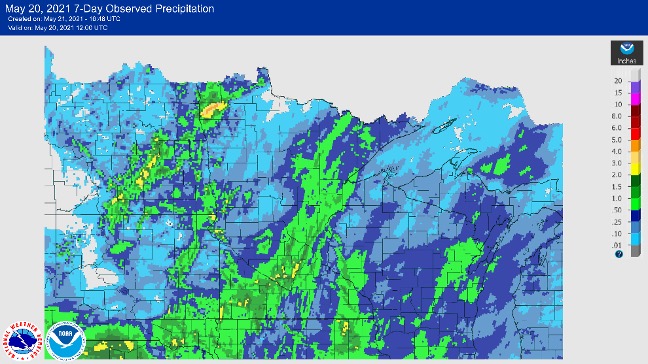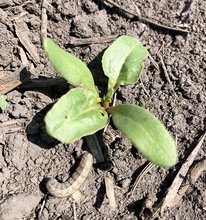Greetings,
Pest alert
I am not aware of any pests threatening impending widespread doom but the timing is right to scout several pests.
Crop weather
Rainfall, air and soil temperatures, degree-days, soil moistures, and other current and historical weather data for the University of Minnesota Southwest Research and Outreach Center (SWROC), a little spot about two miles west of Lamberton, MN, can be found at SWROC Weather.
The moisture situation at the SWROC has improved and I hope it has for you too. There are exceptions but most corn and soybean stands look good. The system Wednesday and Thursday pulled moisture and some insects from south (Figure 1).
Corn
Watch for cutworms while evaluating corn stands and early season weeds. While the migration of black cutworm (and many other insects) into southwest Minnesota has been slow this spring, an April 27-28 migration into Cottonwood, Watonwan, Martin, Nobles, and surrounding counties bears watching. Some moths reached Filmore County in SE MN around the same time. Larvae from this event will large enough to cut small corn around May 30. Cooperative black cutworm 2021-7 provides cutting start and end date projections for corn, scouting tips, and thresholds. Other, less damaging, species might be present so finding a specimen for ID will help make good treatment decisions.
The issue also presents a summary of armyworm captures. Issue 7 also has a link to the web-based version of the recent armyworm publication. Some armyworms made it to northwest Minnesota on these systems last week and armyworm captures have started to increase in black light and pheromone traps.
Soybean
Stands are good where moisture was adequate. Usually, I only get to see problems but Frenchy Bellicot send a picture of a good stand of unifoliate soybeans that were planted on April 4th.
Fields that emerge ahead of others are the ones to cue in on when scouting bean leaf beetle and, in a couple weeks, soybean aphid.
Alfalfa
Alfalfa at the SWROC is getting close to cutting.
Potato leafhoppers were found in alfalfa today. Based on the weather the past few days, I suspected some potato leafhoppers might have made their annual trip north… and I was right. Potato leafhoppers are most often pests of second and third crop alfalfa. They are also pests of dry beans and potatoes.
Egg-laying adults and 1st insect alfalfa weevil larvae are now present in SW MN. Scout before and after 1st cutting to avoid surprises.
Pea aphid populations are increasing but they are drawing predators into fields. If you treat weevils or other insects watch for aphid population flares.
Small grains
In SW MN, winter rye is starting to head.
Spring wheat is tillering – pay attention to herbicide timing to avoid crop injury.
English grain aphid populations remain below threshold levels here at the SWROC. Lady beetles are now starting to forage for aphids and other prey foraging in winter rye and winter week.
Specialty crops
As beets emerge, pay attention to stand reducing insects. There have been some reports of cutworms, but wide-spread prophylactic insecticide applications are probably not the best choices. Black cutworm captures have been focused in the southern two tiers of counties this spring and are less of a threat than some years. When scouting, in addition to cut beets, look for cut plants and leaf feeding of weeds and oat cover crops.
Darol Ike reports dingy cutworms in central MN. These cutworms are active and will be larger now than the species that lay eggs in the spring like blacks. Dingy cutworms lay eggs in late summer and are often associated with fields planted after alfalfa, sunflowers, sod, and weedy soybeans. Because they feed and cut plants above the soil surface, they are less of a threat to small corn than beets and other broadleaves where they can easily cut plants off below the growing point.
Points of interest
- UMN SWROC’s next Advancing Ag webinar is on May 26. The topic is ag business management: z.umn.edu/advancing-ag
- Alfalfa is the topic for next Wednesday’s field notes: https://blog-crop-news.extension.umn.edu/2021/05/join-us-may-26-for-field-notes.html
- Field school is on for 2021: z.umn.edu/fieldschool
Happy trails,


